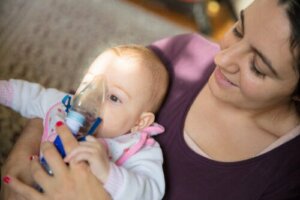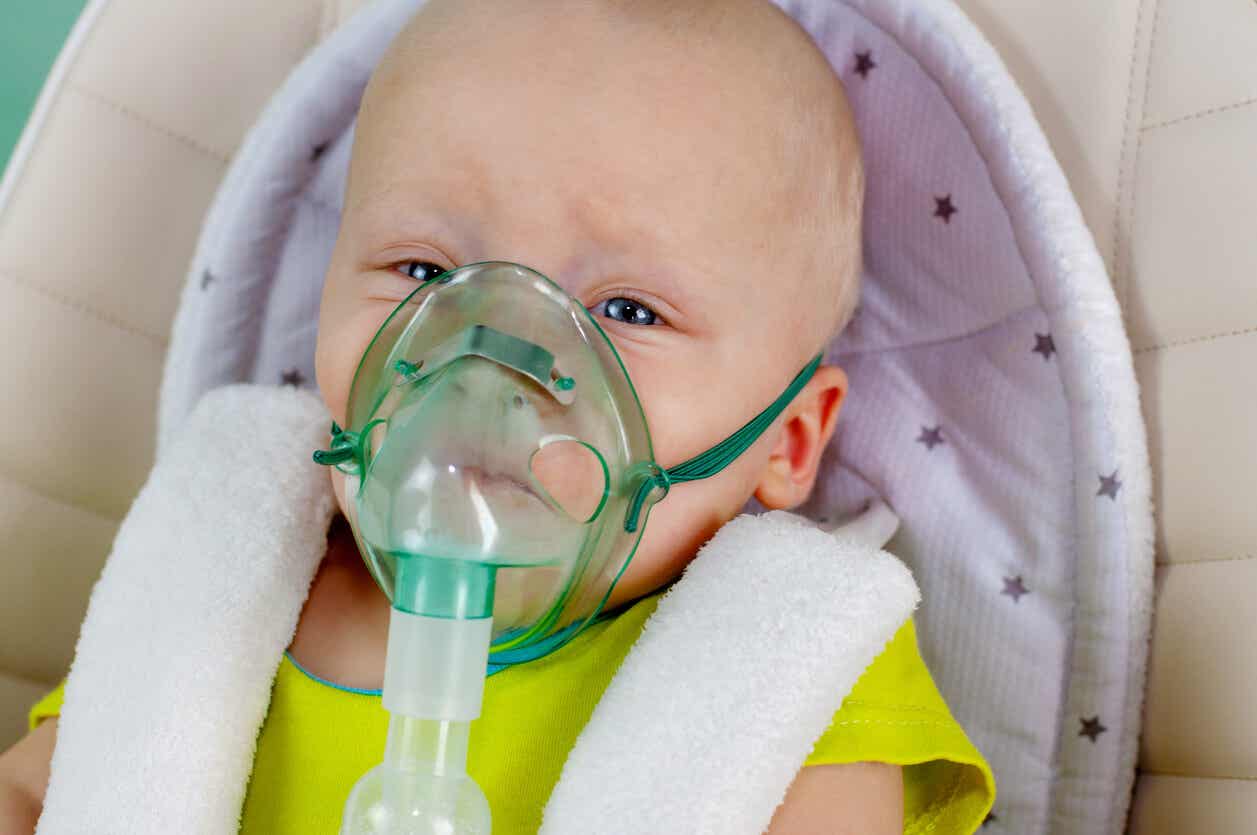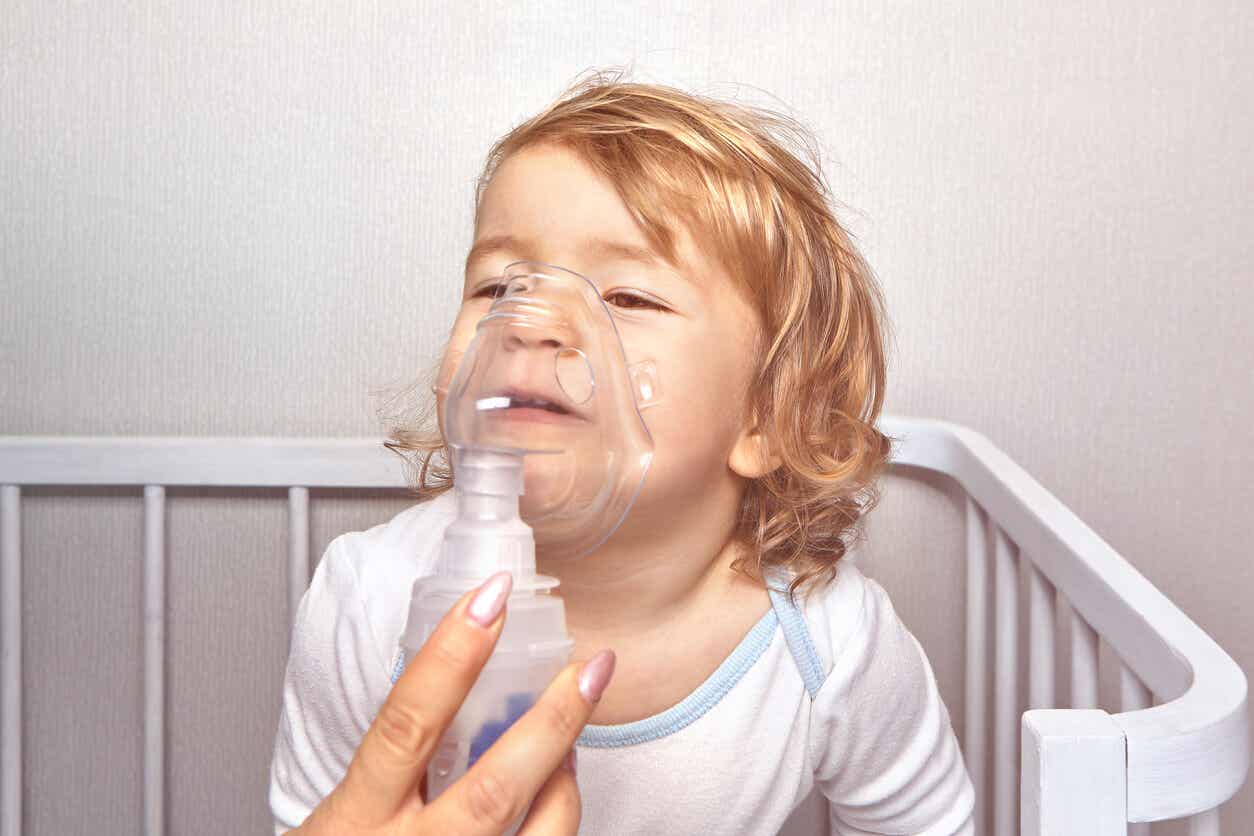Respiratory Physiotherapy for Babies: When and Why?

Respiratory physiotherapy for babies is quite beneficial. It provides immediate results, without causing any kind of pain. In fact, pediatricians recommend it, because it doesn’t cause side effects. Furthermore, it helps reduce respiratory infections and the use of medication.
During the coldest times of the year, respiratory diseases in babies increase. Naturally, babies have mucus secretions because of low temperatures. When the amount of secretions increase, the mucous membrane becomes inflamed. Of course, this makes expelling the secretions more complicated, which affects breathing. The most common signs are cough and nasal secretions.
There are many pulmonary diseases in babies that can be cured by taking respiratory physiotherapy. In fact, this kind of therapy aims at eliminating respiratory tract secretions. What’s more, it helps improve the way babies breathe and their quality of life.

The benefits of respiratory physiotherapy for babies
If children present regular respiratory episodes before they’re two years old, they’ll probably have respiratory problems when they become adults. Respiratory physiotherapy is an effective and safe treatment, which reduces the effects of respiratory diseases in babies. Therefore, it improves their quality of life in the long term.
The different diseases respiratory physiotherapy treats have something in common: The inflammation of the mucous membrane. This membrane is in charge of defending the organism from viruses, bacteria, allergens, toxins, etc. And, its inflammation is what causes mucous discharge.
When this goes untreated, the inflammation continues, and symptoms last longer. As a result, this may lead to more complications in babies. This is why it’s so important to apply respiratory physiotherapy and stop this vicious circle.
When should babies receive respiratory physiotherapy?
Respiratory physiotherapy is recommended for babies whenever they suffer from lung obstruction. What’s more, they should take this treatment whenever they have problems in their airways while breathing. However, it’s inadvisable in the case of tumor diseases or malformations. In fact, this kind of treatment could complicate these situations.
After only a few sessions, respiratory physiotherapy can improve children’s breathing. The sooner you begin the treatment, the better it’ll be for your baby. The techniques included in this treatment aim to reduce secretions and improve breathing. Actually, you can combine this therapy with other treatments and make it more effective.
Different diseases you can treat with respiratory physiotherapy
Respiratory physiotherapy is beneficial in those cases when lung obstruction is reversible. It doesn’t only treat diseases, it also prevents new ones in the future. There are five groups of diseases, according to their main cause:
- Acute and chronic lung diseases: Among acute diseases, we can find bronchitis, bronchiolitis, and pneumonia. There are many chronic diseases, such as allergic diseases and asthma. What’s more, they also include cystic fibrosis, bronchiectasis, and regular infections.
- Diseases in the shared space affecting the respiratory and digestive systems: This includes swallowing problems, which affect respiratory activity.
- Gastroesophageal reflux disease: This produces an increase in secretions in the upper airways.

- Diseases related to childbirth: Some of them might be due to swallowing amniotic fluid or immature lungs. They also include lung infections in newborns.
- Respiratory diseases in the upper airways: These include the nose, the mouth, the throat, and the larynx. An increase in secretion in the upper airways can extend to the trachea and the lungs.
A conservative treatment
The kind of treatment respiratory physiotherapy offers reduces the use of medication in babies. These are passive techniques, which can even be performed at home. In the case of babies, all techniques are passive.
Depending on the seriousness of the disease, the treatment can be outpatient or take place at home. In the case of more serious situations, respiratory physiotherapy is performed wherever the baby is hospitalized. This therapy improves babies’ health and reduces the time they need to spend at the hospital. Respiratory physiotherapy in babies should be performed as a game, in a pleasant context, with family and friends.
Respiratory physiotherapy for babies is quite beneficial. It provides immediate results, without causing any kind of pain. In fact, pediatricians recommend it, because it doesn’t cause side effects. Furthermore, it helps reduce respiratory infections and the use of medication.
During the coldest times of the year, respiratory diseases in babies increase. Naturally, babies have mucus secretions because of low temperatures. When the amount of secretions increase, the mucous membrane becomes inflamed. Of course, this makes expelling the secretions more complicated, which affects breathing. The most common signs are cough and nasal secretions.
There are many pulmonary diseases in babies that can be cured by taking respiratory physiotherapy. In fact, this kind of therapy aims at eliminating respiratory tract secretions. What’s more, it helps improve the way babies breathe and their quality of life.

The benefits of respiratory physiotherapy for babies
If children present regular respiratory episodes before they’re two years old, they’ll probably have respiratory problems when they become adults. Respiratory physiotherapy is an effective and safe treatment, which reduces the effects of respiratory diseases in babies. Therefore, it improves their quality of life in the long term.
The different diseases respiratory physiotherapy treats have something in common: The inflammation of the mucous membrane. This membrane is in charge of defending the organism from viruses, bacteria, allergens, toxins, etc. And, its inflammation is what causes mucous discharge.
When this goes untreated, the inflammation continues, and symptoms last longer. As a result, this may lead to more complications in babies. This is why it’s so important to apply respiratory physiotherapy and stop this vicious circle.
When should babies receive respiratory physiotherapy?
Respiratory physiotherapy is recommended for babies whenever they suffer from lung obstruction. What’s more, they should take this treatment whenever they have problems in their airways while breathing. However, it’s inadvisable in the case of tumor diseases or malformations. In fact, this kind of treatment could complicate these situations.
After only a few sessions, respiratory physiotherapy can improve children’s breathing. The sooner you begin the treatment, the better it’ll be for your baby. The techniques included in this treatment aim to reduce secretions and improve breathing. Actually, you can combine this therapy with other treatments and make it more effective.
Different diseases you can treat with respiratory physiotherapy
Respiratory physiotherapy is beneficial in those cases when lung obstruction is reversible. It doesn’t only treat diseases, it also prevents new ones in the future. There are five groups of diseases, according to their main cause:
- Acute and chronic lung diseases: Among acute diseases, we can find bronchitis, bronchiolitis, and pneumonia. There are many chronic diseases, such as allergic diseases and asthma. What’s more, they also include cystic fibrosis, bronchiectasis, and regular infections.
- Diseases in the shared space affecting the respiratory and digestive systems: This includes swallowing problems, which affect respiratory activity.
- Gastroesophageal reflux disease: This produces an increase in secretions in the upper airways.

- Diseases related to childbirth: Some of them might be due to swallowing amniotic fluid or immature lungs. They also include lung infections in newborns.
- Respiratory diseases in the upper airways: These include the nose, the mouth, the throat, and the larynx. An increase in secretion in the upper airways can extend to the trachea and the lungs.
A conservative treatment
The kind of treatment respiratory physiotherapy offers reduces the use of medication in babies. These are passive techniques, which can even be performed at home. In the case of babies, all techniques are passive.
Depending on the seriousness of the disease, the treatment can be outpatient or take place at home. In the case of more serious situations, respiratory physiotherapy is performed wherever the baby is hospitalized. This therapy improves babies’ health and reduces the time they need to spend at the hospital. Respiratory physiotherapy in babies should be performed as a game, in a pleasant context, with family and friends.
All cited sources were thoroughly reviewed by our team to ensure their quality, reliability, currency, and validity. The bibliography of this article was considered reliable and of academic or scientific accuracy.
- Ibarra Cornejo, José, et al. “Efectividad de las diferentes técnicas de fisioterapia respiratoria en la bronquiolitis. Revisión sistemática.” Revista Médica Electrónica 39.3 (2017): 529-540. http://scielo.sld.cu/scielo.php?pid=S1684-18242017000300011&script=sci_arttext&tlng=en
- Esteban Sotomayor, Magaly Edith, and Fanny Marylin Pulache Bernal. “EFECTIVIDAD DE LAS TECNICAS RESPIRATORIAS PARA MEJORAR EL ESTADO CLÍNICO EN LACTANTES CON BRONQUIOLITIS AGUDA.” (2020). http://repositorio.uwiener.edu.pe/handle/123456789/3865
- Conesa Segura, Enrique. “Evaluación clínica de la respuesta a la fisioterapia respiratoria en los niños con diagnóstico de bronquiolitis aguda.” (2019). http://repositorio.ucam.edu/handle/10952/4136
- Gonnet, Anthony Robert. “Influencia de la fisioterapia respiratoria sobre la calidad de vida en los niños con bronquiolitis: Protocolo de un ensayo clínico aleatorizado.” (2019). https://repositorio.usj.es/handle/123456789/227
- Pírez, Catalina, et al. “Fisioterapia respiratoria en el tratamiento de niños con infecciones respiratorias agudas bajas.” Archivos de Pediatría del Uruguay 91 (2020): 38-39. http://www.scielo.edu.uy/scielo.php?pid=S1688-12492020000700038&script=sci_arttext
- Leone, Mariela. “FISIOTERAPIA RESPIRATORIA EN PACIENTES PEDIÁTRICOS CON DIAGNÓSTICO DE BRONQUIOLITIS Y NEUMONÍA DEL HOSPITAL JUAN PABLO II CORRIENTES Y HOSPITAL SAMIC OBERÁ.” http://190.226.53.212/greenstone/collect/tesis/index/assoc/HASH0192.dir/TFI%20Sabotke%20Gonzalo.pdf
This text is provided for informational purposes only and does not replace consultation with a professional. If in doubt, consult your specialist.








